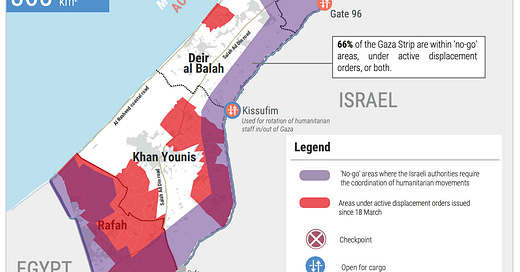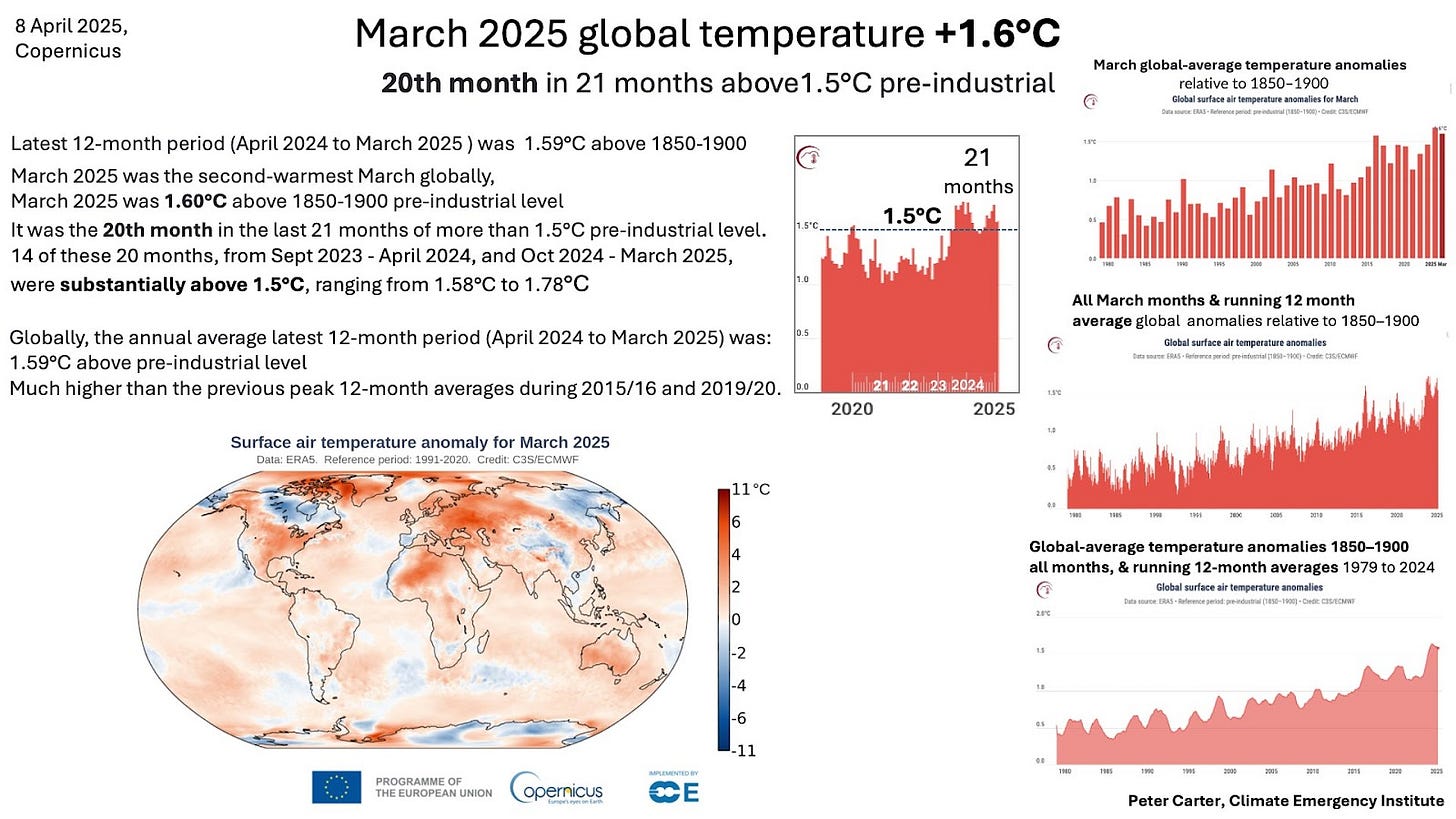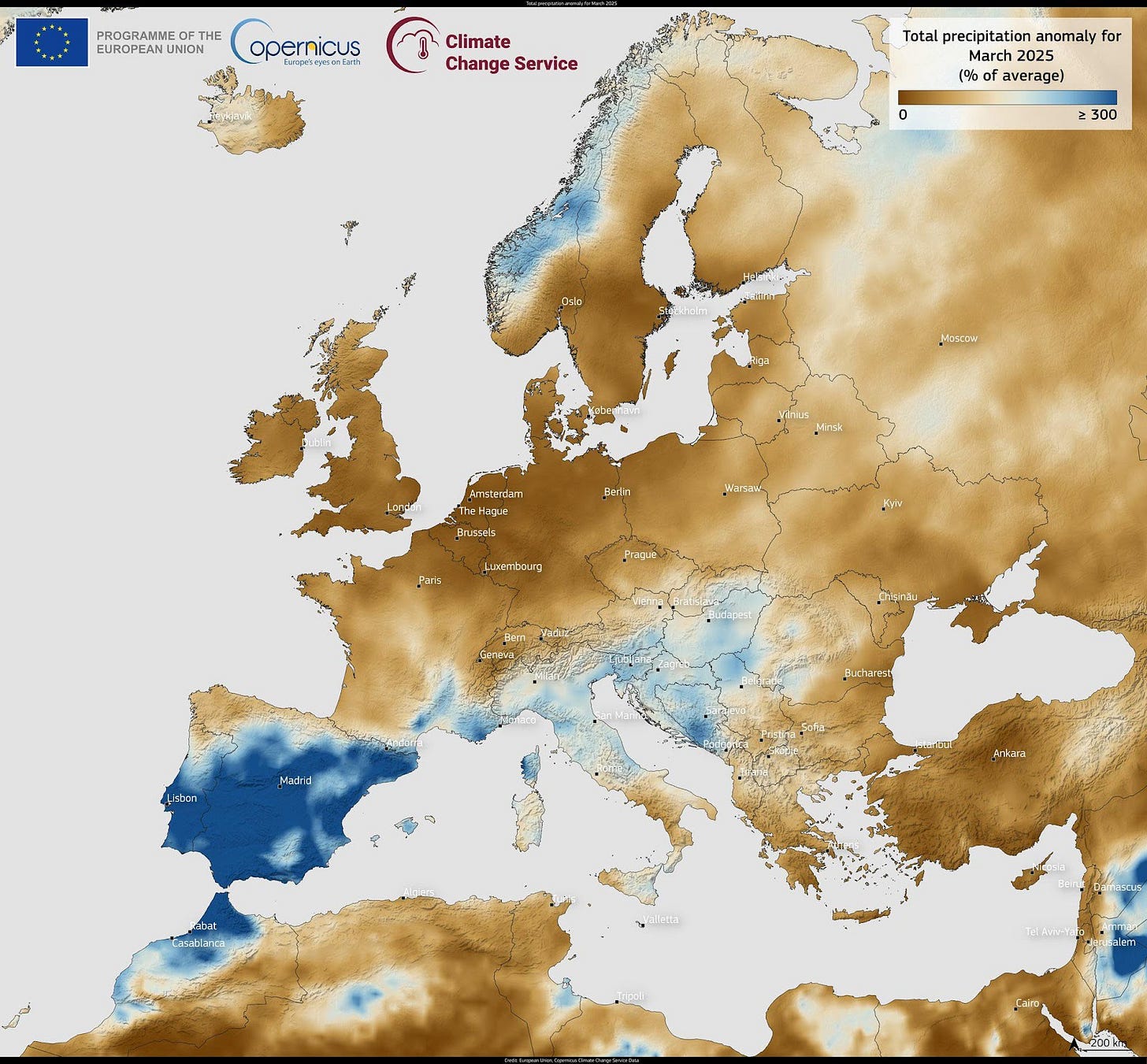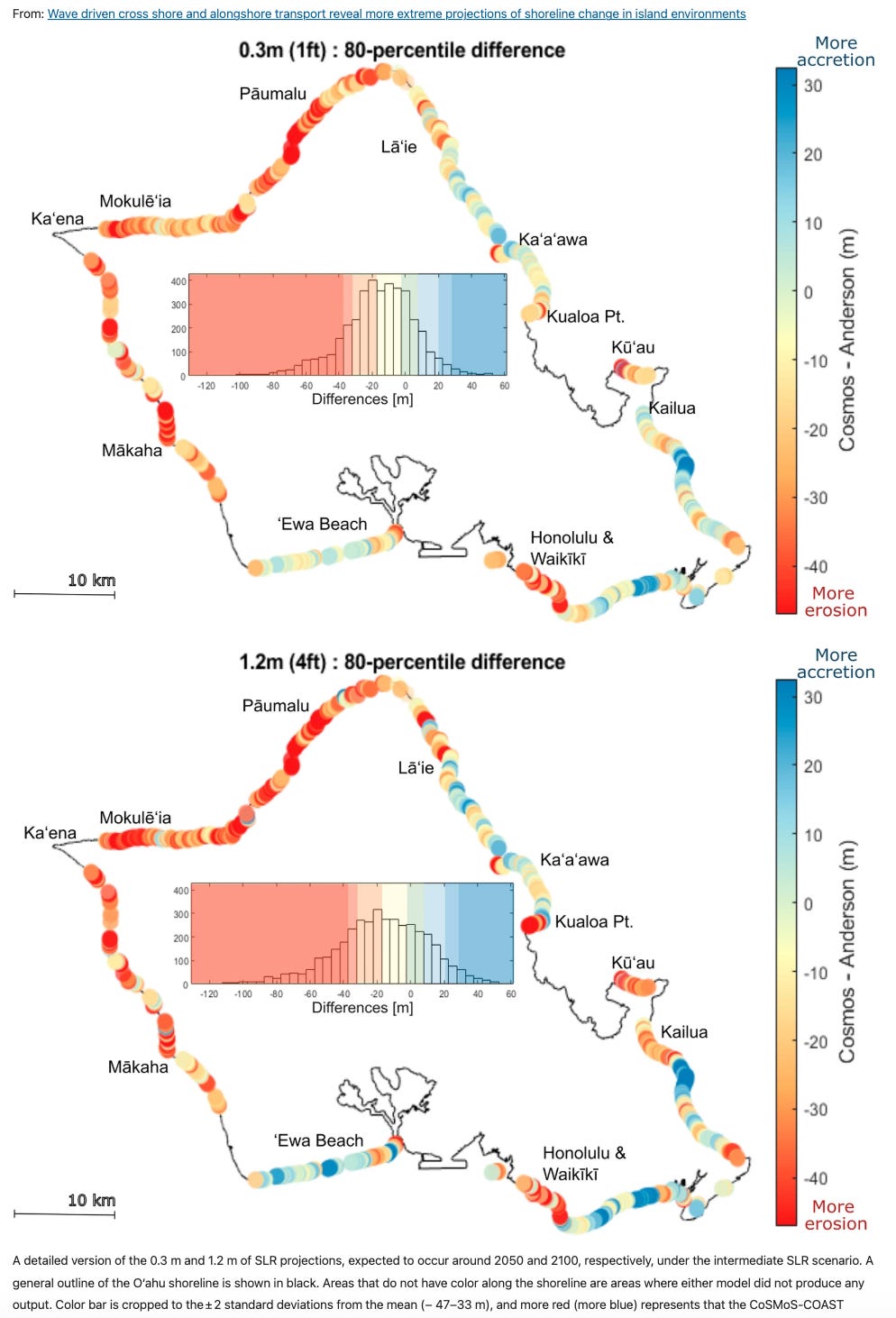Last Week in Collapse: April 6-12, 2025
Coal, plastics, temperature records, large-scale economic manipulation, and the specter of martial law. The bloody writing’s on the wall.
Last Week in Collapse: April 6-12, 2025
This is Last Week in Collapse, a weekly newsletter compiling some of the most important, timely, useful, soul-crushing, ironic, amazing, or otherwise must-see/can’t-look-away moments in Collapse.
This is the 172nd weekly newsletter. You can find the March 30-April 5, 2025 edition here on Reddit if you missed it last week. A sincere thank you for subscribing to the Substack version, and especially to my paying subscribers.
——————————
In Memoriam: Infiernos Glacier. Scientists say in a prepublication study that the glacier in the Pyrenees mountains “can no longer be considered a glacier but an ice patch.” Although the report is new, the diagnosis is old—Infiernos actually stopped being a glacier in 2023.
“A glacier is a mass of ice on the land surface which flows downhill under gravity and is constrained by internal stress and friction at the base and sides. Ice patch is an ice body without movement by flow or internal action. This way, the absence of movement is the main difference between a glacier and an ice patch. Similarly, stagnant ice (also known as dead ice) is that ice without movement.” -some definitions
The EU”s Copernicus Climate Change Service announced that last March was the bloc’s hottest on record, breaking the old record by 0.26 °C—although globally last March ranks as our second-warmest. March was also quite dry in Europe, Iberia excepted. Arctic sea ice continues to set record lows for this time of the year. Twenty of the last twenty-one months have exceeded 1.5 °C warming. The implications are enormous: “extreme options” for climate repair may be our only salvation.
An avalanche killed two climbers in Nepal. Worsening Drought in Pakistan’s Punjab province; the Indus River is facing the worst Drought in 100+ years. Several locations in Indonesia hit new April minimum temperatures before the month is half over. And an inland town in Brazil broke April temperature records, clocking 40 °C (104 °F).
Indians and Bangladeshis are concerned about a future Chinese dam being constructed on the Brahmaputra River in Tibet—which will also become the world’s largest power plant. They say that there are important issues of water rights at stake, and that river sediment will be blocked, impacting agriculture & local economies. The dam is also being situated in a region known for earthquakes, which could one day destroy the dam and unleash a cataclysmic flood downstream.
A river in the UK has been granted legal rights, one of the first in modern times. The Aral Sea, which formerly lay between Kazakhstan and Uzbekistan (90% has dried up over the past decades), is now seeing the earthen lakebed rising about 7mm a year.
A recent study’s scientists “introduce the concept of thirstwaves—prolonged periods of extremely high evaporative demand” on earth’s surface…The authors conclude, “Over time, all aspects of these thirstwaves have gotten worse. It has also become much less likely that a growing season will pass without any thirstwaves.”
The three weeks after the start of spring were, on average, the windiest in U.S. recorded history. Nine states’ data indicates it was their 2nd windiest March overall. Tornados across the country are also above average. Locations in the U.S. northeast also saw rare snowfall in mid-April. A few locations in Mexico hit 48 °C last week (118 °F).
The U.S. Global Change Research Program (USGCRP), a collection of workers from 15 federal agencies, publishes a National Climate Assessment roughly once every five years. Published, I should say; DOGE has axed the department altogether. In the same, week, President Trump signed an executive order to boost production of “beautiful clean coal” by limiting state-level actions to thwart unchecked carbon emissions.
A couple weeks ago, NOAA’s “Polar Vortex Blog” reported, while it still can, that the polar vortex ended earlier than usual—and expected. It is “the second-earliest final warming since 1958.”
Flooding in Kinshasa killed 33+ people last week, following a week of heavy rain. Wildfires in Nepal are crowding hospitals, and have made the capital the most air-polluted city in the world for over a week now. A pair of studies outlines possible carbon removal strategies, analyzing them for political realism, desirability, “justice,” and efficiency. A swath of spots in Siberia exceeded 30 °C (86 °F) in the first half of April for the first time.
The International Maritime Organization met last week to discuss net-zero targets, and agreed on a somewhat convoluted system akin to cap-and-trade. A paper published in Earth’s Future suggests their net-zero shipping targets may actually be reached by 2030—but will fail to meet 2050 goals. “Decarbonization is expected to rely on a mix of short-term operational improvements, technological upgrades, and long-term shifts to alternative energy sources, though there is no consensus on which fuels will dominate.”
A study in One Earth says that Bangladesh’s exposed coastline could see 1-in-100-year storm tides every decade from now on. Many of these destructive tides will take place during the monsoon season, which has not—until recently—overlapped with the season of tropical cyclones. “People won't have any reprieve between the extreme storm and the monsoon. There are so many compound and cascading effects between the two. And this only emerges because warming happens,” one MIT scientist said.
A study on coastal erosion looked at Oahu as a bellwether for beach loss. The scientists found that 40% of “the sandy beach coastline could experience beach loss…happening by 2030.” Experts believe similar dynamics may be attributable to other Pacific islands.
——————————
Spain is struggling with surging property prices, doubling the average rent over the last decade. Iran’s currency, the rial, fell to record lows last week, when measured against the USD; it is expected to continue dropping, like Venezuela’s currency is—and South Korea’s currency.
Although U.S. stocks saw a tremendous spike on Wednesday (the S&P’s biggest one-day in 17 years, courtesy of naked ‘market manipulation’ ), the following day saw large declines across most stocks. The junk bond reckoning is coming, and a recession. Layoffs are on their way, and there are few safeguards left for the global economy this time. Ambition for launching a Digital Euro is growing; will global recession hit first? Goldman Sachs is suggesting that crude oil futures could hit $40: “in a more extreme and less likely scenario with both a global GDP slowdown and a full unwind of OPEC+ cuts, which would discipline non-OPEC supply, we estimate that Brent {crude oil} would fall just under $40 a barrel in late 2026.”
Experts say recent tariffs have done extreme damage to globalization and the system of mostly-good-faith trading established over decades. Although many countries and blocs, like the EU, have paused retaliatory tariffs to let negotiations—and exceptions—unfold, China has increased their tariffs on American goods to 125%. After years of partial economic decoupling, neither the Americans nor the Chinese are likely to blink first in a contest of tariffs…although America’s sweeping tariffs on Chinese goods now has an exception for a suite of consumer tech products……and accusations are incoming of colossal insider trading. “It's a big club—and you ain't in it.”
A drug-resistant strain of the mysterious bacteria Acinetobacter baumannii has been confirmed in a Malaysian hospital. A study of pollution in the UK’s rivers and south coast waters found greatly elevated levels of drugs (legal & illegal), industrial chemicals, and some pesticides banned 10+ years ago; officials blame sewers overflowing during high-rain periods in March & November.
Contaminants are moving up the food chain. Birds in Svalbard are testing for elevated mercury levels—and heavy metals, as are penguins in Antarctica. Cocaine exports to Europe are surging. Argentinans conducted a general strike in advance of a massive IMF bailout; the country has received the most IMF bailouts in history, with 22 IMF “loans” so far.
A study in Communications Earth & Environment did a stocktake on global plastics production by industry—and recycling rates. The conclusion is not inspiring: only 9.5% of plastic production comes from recycled plastic. The global production of plastics is expected to roughly double from 436M tons annually (in 2022) to over 800M tons by 2050. Over the past 75 years, plastics production has increased by about 8.4% annually.
“Around 98% of the global virgin plastics produced in 2022 is generated from fossil-fuel based feedstocks (44% derived from coal, 40% from petroleum, 8% from natural gas, 5% from coke and 1% from other sources). Only 2% of the global plastics feedstocks are generated from bio sources….Furthermore, there is a significant shift in waste disposal: incineration is emerging as a prominent waste disposal method (34%), landfill is decreasing substantially (40%), while the global recycling rate remained stagnant (9%)....A total of 382.12 Mt of plastics entered the use stage, with 158.04 Mt in packaging, 72.05 Mt in building and construction, 32.02 Mt in automotive, 28.02 Mt in electrical and electronics, 28.01 Mt in household and textile, 16.01 Mt in agriculture…The largest importer of plastics final products was EU28 (35%), followed by USA (20%), Oth{er} Asia (14%), ROW (13%), China and Middle East (5% each), Africa (4%), Japan (3%) and India (2%)...” -excerpts from the study
Keep reading with a 7-day free trial
Subscribe to Last Week in Collapse to keep reading this post and get 7 days of free access to the full post archives.











